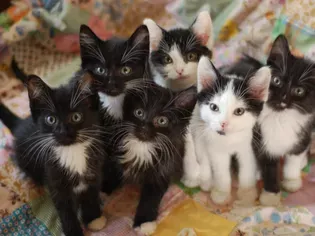How Many Litters Can a Cat Birth in One Year?
Updated on 04/26/24

Unlocking the Feline Reproductive Mystery: Exploring the Frequency and Litter Size of Cats
Introduction
Cats, the enigmatic companions of households worldwide, have captivated hearts for centuries. Their independent nature, playful antics, and affectionate cuddles have made them beloved family members. Yet, beneath their charming exterior lies a biological prowess that remains shrouded in mystery for many cat enthusiasts: their reproductive capabilities. As responsible pet owners and curious minds alike, understanding the intricacies of feline reproduction is paramount. Join us as we delve into the fascinating world of cat litters, exploring the frequency and size of these feline families.
The Feline Reproductive Cycle
The journey towards feline motherhood begins with a unique reproductive cycle, governed by a complex interplay of hormones and physiological changes. Female cats, known as queens, reach sexual maturity between the ages of 4 to 10 months, signaling the onset of their reproductive capabilities. The estrous cycle, also referred to as the heat cycle, is a recurring pattern that governs the queen's receptiveness to mating. This cycle typically lasts for approximately 2-3 weeks, with periods of estrus, or heat, interspersed with periods of diestrus, when the queen is not receptive.
During estrus, the queen releases pheromones that attract male cats, known as tomcats. These pheromones create a chemical trail that guides tomcats towards potential mates. Once a receptive queen and a willing tomcat have found each other, mating occurs, initiating the potential for conception.
Litter Frequency: A Tale of Seasons and Environmental Cues
The frequency with which a queen can produce litters is influenced by a combination of factors, including seasonal variations and environmental cues. In temperate climates, queens typically experience a surge in reproductive activity during the spring and summer months, aligning with the abundance of food and favorable conditions for kitten survival. During these peak breeding seasons, queens may produce multiple litters in rapid succession.
Environmental factors also play a role in litter frequency. Queens exposed to longer daylight hours, such as those living in regions closer to the equator, tend to have more frequent estrous cycles and consequently, more litters per year. Conversely, queens in regions with shorter daylight hours may experience fewer reproductive cycles and produce fewer litters annually.
Litter Size: Unveiling the Genetic and Environmental Determinants
The size of a cat litter, the number of kittens born to a single queen, is a fascinating aspect of feline reproduction. Litter size is influenced by a combination of genetic and environmental factors.
Genetic Determinants: Breed plays a significant role in determining litter size. Certain breeds, such as the Siamese and Burmese, are known for producing larger litters, typically ranging from 4 to 6 kittens. On the other hand, breeds like the Russian Blue and the Sphynx tend to have smaller litters, usually consisting of 1 to 3 kittens.
Environmental Determinants: The queen's age, health, and nutritional status can also impact litter size. Younger queens, those in optimal health, and those receiving proper nutrition are more likely to produce larger litters. Conversely, older queens, those with underlying health conditions, and those experiencing malnutrition may experience reduced litter sizes.
Exceptional Examples: Unraveling Record-Breaking Litters
While litter sizes vary depending on the aforementioned factors, exceptional cases occasionally occur, pushing the boundaries of feline fertility. Record-breaking litters, consisting of 8 or more kittens, are rare but not unheard of. These extraordinary events often involve queens of specific breeds, such as the Maine Coon, known for their large size and prolificacy.
Implications for Responsible Pet Ownership
Understanding the frequency and size of cat litters is not merely a matter of trivia but holds practical implications for responsible pet ownership. By recognizing the reproductive potential of cats, we can proactively prevent unwanted litters and ensure the well-being of both mother cats and kittens.
Spaying and neutering, the surgical sterilization of cats, is a highly effective method of preventing unplanned pregnancies and its associated challenges. It eliminates the risk of unwanted litters, reduces the spread of sexually transmitted diseases, and contributes to the overall health and longevity of cats.
Conclusion
The reproductive capabilities of cats are a captivating blend of biological intricacy and environmental influences. Understanding the frequency and size of cat litters empowers responsible pet owners with valuable knowledge for making informed decisions regarding their feline companions. By embracing proactive measures like spaying and neutering, we can safeguard the well-being of cats, prevent overpopulation, and foster a harmonious coexistence between humans and these enchanting creatures.
Explore More Pets

Cat Behavior Problems
How to Stop Aggression in Kittens

Long-Haired Cat Breeds
Siberian Cat: Breed Profile, Characteristics, & Care

Cat Behavior Problems
How to Stop Kittens From Scratching and Biting

Long-Haired Cat Breeds
Turkish Angora: Cat Breed Profile, Characteristics & Care

Basic Training
How to Socialize Your Kitten

Short-Haired Cat Breeds
Cute Pictures & Facts About Calico Cats & Kittens

Litter Box Training
Training Your Kitten to Use the Litter Box

Long-Haired Cat Breeds
10 Fun Facts About White Cats